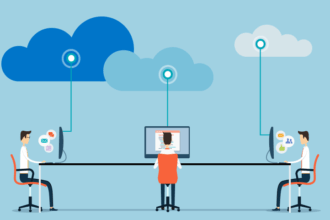 In a recent article in Forbes, David Yarnold explains that SAP ERP system rigidity has squelched creativity and contributed to the loss of manufacturing jobs in the US economy.
In a recent article in Forbes, David Yarnold explains that SAP ERP system rigidity has squelched creativity and contributed to the loss of manufacturing jobs in the US economy.
 In a recent article in Forbes, David Yarnold explains that SAP ERP system rigidity has squelched creativity and contributed to the loss of manufacturing jobs in the US economy. He further postulates that Cloud ERP systems will replace SAP and restore creativity to the universe.
In a recent article in Forbes, David Yarnold explains that SAP ERP system rigidity has squelched creativity and contributed to the loss of manufacturing jobs in the US economy. He further postulates that Cloud ERP systems will replace SAP and restore creativity to the universe.
“It’s time for companies to move on. To eliminate these massive shackling on-premise systems that have been inhibiting growth and creativity for so long. Stop pushing aside innovative projects because they simply can’t be done under SAP. It’s time to get creative again, fuel growth and create the jobs that our country and others desperately need. SAP’s efficiency allowed companies to cut jobs and costs. The cloud will maintain that efficiency but re-integrate the level of creativity that these great companies once thrived on.”
The Cloud delivers many benefits to ERP software designers. Access from anywhere, scalability, reduced IT costs, pay-as-you-go, and elimination of client software are among many benefits. Building Cloud ERP systems as web-based applications, delivers even more benefits as discussed in a previous ERP Cloud News posting. However, the claims made in the aforementioned article are exaggerated and require some clarification.
A Rebuttal, a Clarification, and Support for Cloud ERP
Accounting and ERP software is designed to drive efficiencies. Sometimes innovation competes with efficiency. For example, if you sell 1 million widgets/year and you can reduce the cost of sales by $1/widget by automating your ordering process, then paying $500,000 to customize your ERP system is a good business decision. If you are a small business and plan to sell 1,000 better widgets your first year, then a large upfront customization fee to SAP, Oracle, or any other vendor is not advisable.
The example above shows that the cost/benefit analysis stifles innovation more than the system itself. That said, if the cost of the customization can be reduced, then the business case is easier to prove and companies can innovate faster. Modern ERP systems can accomplish this by eliminating client software, providing modern web-services APIs, and delivering web-based customization tools.
Rebuttal: SAP in the Cloud
Although not mentioned in the article, SAP has demonstrated that it is taking the cloud seriously through the launch of Business ByDesign as well as their work on a cloud-based platform. SAP might be too expensive. SAP might be too big for mid-sized businesses. SAP might be process driven. But I wouldn’t call SAP inflexible. If your business has a healthy budget (read millions) and large volumes of transactions to automate, then you can make SAP do just about anything. See sidebar “ERP and innovation.”
Clarification: Some Clouds are More Rigid than On-Premise
The his article, Mr. Yarnold states “the dominant rigidity of on-premise ERP systems appears to be evaporating with the advent of more flexible cloud-based applications.”
Clarification: Multi-tenant cloud-based systems can be more rigid than on-premise deployments. With multi-tenancy, you gain some efficiency, but you lose control of the source code because it is shared by many users. I’ve worked with many multi-tenant applications (ERP, CRM, marketing automation) that allow you to define variables, parameters, and custom work flows – so I would not call them inflexible. If you can accomplish what’s needed with configuration (not customization), then the cloud will save you time and money. The key is knowing what you can accomplish with configuration. If your process requires core logic changes, then you will get faster results with an on-premise vendor.
Flexible Cloud ERP
The best of both worlds is an on-premise cloud implementation. On-premise clouds are more flexible and much less expensive than a client-server deployment. Modern development tools with web-based APIs eliminate client software and deliver robust applications to a web-browser. Since these applications are managed centrally, they can be designed and deployed faster and cheaper than client-server software.
Unlike multi-tenant cloud applications, on-premise clouds provide access to source code. Before starting your customization, make sure that the vendor protects your customizations during software upgrades. Otherwise, you will have to reinstall or redevelop your customized code during each upgrade cycle. A single tenant application will also allow you to upgrade your application at a time that is convenient for you. The multi-tenant upgrade will occur automatically, but at a time specified by the vendor.
Conclusion: Cloud ERP helps drive Efficiency and Innovation
David Yarnold’s article endorses modern cloud ERP software. But the article goes too far by saying all cloud systems are more flexible than on-premise systems and misses the fact that SAP is pursuing cloud strategies. I would not blame job loss, lack of creativity, and the demise of some US manufacturing sectors on ERP software.
ERP software is designed to make business processes (sales, orders, manufacturing, accounting, invoicing, etc.) more efficient. The cloud accomplishes this by offering rapid scalability, pay-as-you-go pricing, and eliminating the burden of client-software.
When choosing a cloud solution, the ability to customize and connect with other systems is critical. Core accounting processes are rules-based and need to be flexible and open, but not innovative. ‘Creative accounting’ usually leads to big problems and falling stock prices. However, inaccessible and unconnected accounting systems are just as dangerous. Innovative manufacturing processes, line-of-business applications, support processes, and other business advantages need to be easy to plug-in to the core accounting, ordering, inventory, and management processes offered by the ERP system.
ERP systems should make businesses more efficient and provide them with the tools to innovate. Cloud and web-based systems offering SaaS and on-premise deployments provide the flexibility and efficiency required to reduce the cost of innovation. This allows new ideas to be implemented faster and sooner than legacy software solutions – making Cloud ERP systems both efficient and innovative.







